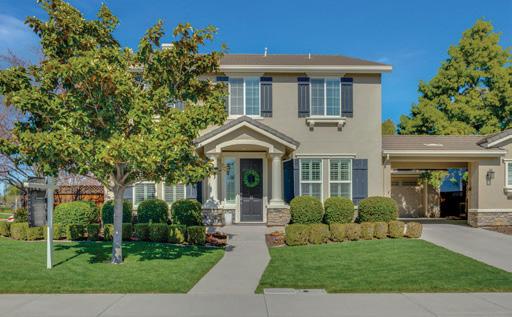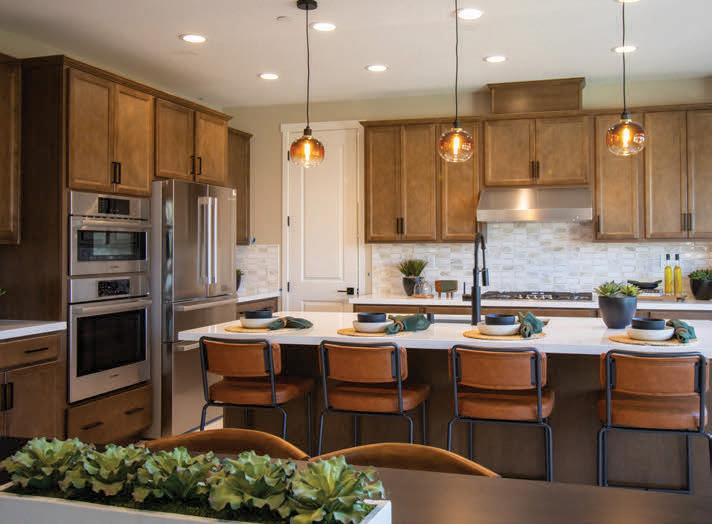








Mortgage rates have dropped slightly, but concerns about inflation and the future of the economy have East County experts wondering which direction the housing market will trend.
Interest rates for a 30-year fixed mortgage rate stand as of March 17 at 6.69 percent whereas a 15-year fixed rate is 5.98 percent, according to Bankrate.com. That is a slight decrease from interest rates from this time last year.
“Currently, mortgage rates are around 6.5 percent, which are good when you view rates from a historical standpoint,” said Oakley mortgage broker Eric Love. “However, they don’t compare to the low 3 percent rates of recent memory.”
The higher mortgage rates, while coming down slightly from their peak, are still higher than the historically low rates seen in recent years, as elevated monthly mortgage payments can affect affordability for prospective homebuyers. According to Love, the housing market is a sellers’ market due to overvalued houses and lack of inventory. However, the tide is slowly
turning back into a buyers’ market.
“My advice to prospective homeowners who want to sell their home would be to sell now while it’s a sellers’ market,” Love said. “The prices are up so high that they only have one place to go, and that’s down.”
The economy is experiencing a mix of stabilization and uncertainty at the national level due to cooling inflation and steady job growth, but with fluctuating interest rates, global economic pressures, and potential policy changes. Interest rates remain a key factor, as the Federal Reserve is closely monitoring inflation before making any significant rate cuts, according to Naja Phillips, Realtor at Keller Williams East County Realty.
“Buyers should be prepared to act decisively when they find the right property, as competition still exists in desirable neighborhoods,” Phillips said. “For local buyers in the Bay Area, this means a continued focus on budgeting wisely and exploring loan options that make homeownership attainable. The demand for housing remains strong due to limited inventory, and home prices are holding steadily.”
According to Phillips, the market is leaning towards a more balanced state. But in many parts of the Bay Area, sellers still have the advantage due to limited housing supply. However, with the fluctuation
of interest rates, buyers who have been waiting to buy could re-enter the market, which could create more competition. Phillips says it is crucial for sellers to price a home correctly and to ensure it is ready for the market. For buyers, persistence and preparation are key, along with being open to creative financing solutions.
“For sellers, this could be an opportunity to attract motivated buyers, especially if inventory remains low,” Phillips said. “For buyers, it’s essential to stay informed, be financially prepared, and work with a knowledgeable real estate professional to help navigate potential market shifts.”
According to Patrick McCarran, real estate broker from Realty One Group Elite in Brentwood, the market should remain mostly steady for 2025 without any drop in values, barring any major crisis.
“My advice to buyers is ‘no time like the present,’ “ McCarran said. “There’s no guarantee that rates won’t go up so it’s good to lock him in now, and if they drop they can always refinanced. Same goes for sellers if you’re looking to make a life change. There’s no time like the present.”
Phillips, while noting it is hard to make an accurate analysis, predicted a more balanced market for 2025 if the Federal Reserve begins lowering interest rates. This could lead to increased buying, since more people will be able to afford homes. But this could also lead to rising home prices
due to more demand.
“For buyers, do get pre-approved for a loan before starting your search--this gives you - competitive edge,” Phillips said. “Do work with an experienced agent who understands the local market and can help you make strong offers. Do be patient and flexible--finding the right home takes time, but the right strategy will get you there. Don’t make emotional decisions or stretch your budget too thin. Don’t assume waiting will necessarily get you a better deal. If interest rates drop, competition could drive prices up.”
Phillips advised that those interested in selling their homes price their homes competitively because overpricing can cause homes to sit on the market longer than necessary. He also stressed the importance of not waiting too long if one is ready to sell. Since market conditions can shift, timing can impact the sale price.
“Invest in minor upgrades, staging, and curb appeal to make your home stand out,” Phillips said. “Be open to negotiation, as buyers today are looking for value and may ask for concessions. Don’t ignore the importance of marketing -- professional photos, online listings, and a strong agent can make a huge difference.”
For more information, contact Naja Phillips at 925-494-8261or Patrick McCarran at 925-899-5536, visit www. najaphillips.kw.com.












BY TAYLOR SHEPHERD
With the already expensive price tag on products,
President Trump’s tariffs on goods from China, Mexico and Canada are making homes nationwide and in East County more expensive.
“Industry estimates suggest an increased cost of 5% to 20% per new home, which will likely be passed onto buyers,” according to the San Francisco Chronicle. “The tariffs could also result in fewer homes being built, leading to higher competition.”
Heid Hurst, a Brentwood Realtor for The Hurst Team, said what the U.S. is experiencing now and have been for years is inflation. For the real estate industry as a whole, Hurst said that there is a global effect that brings Americans jobs to the U.S., those overseas come back and that allows more people to want to buy houses here.
“People lose jobs over the tariffs because of the high costs of tariffs,” she said.
Jeff Kenney, a Brentwood Realtor for JDK & Associates Realty Inc., said it seems too early to put blame on today’s economy and the slowdown of the real estate market in Brentwood on tariffs.
“Prices have softened and sellers are slow to lower their expectations understandably,” Kenney said. “High interest rates have put purchasing on hold with many first-time buyers, as some who would sell to downsize or go bigger for the growing family, locked in several years ago at incredibly low rates (i.e. 2.75%) and won’t move forward with rates near or at 7%.”
Kenney added that this would raise a buyer’s mortgage rates immensely.
“The housing prices in Brentwood have remained steady over the past few years, but homes that used to say ‘pend-


ing’ with an accepted offer that were once in the teens, are now taking closer to 45 days to find a buyer,” he said.
Although unsure about the future of home buying and Realtors, Hurst added that on a scale of being a buyer agent, she sees a lot of multigenerational families moving in together.
“A lot of people will have to brace themselves for years or repair,” Hurst said. “Next year will be better for buyers and sellers.”
In January 2022, the median home price for Brentwood was $850,000. In January 2025, it was $840,000. With the ‘pause’ Kenney has witnessed from home buyers in today’s market, these prices could continue to drop.
“Brentwood’s real estate market, in my opinion, will continue to have a bright future,” he said. “You can still get more home for your money here than in other Bay Area markets.”
Both Hurst and Kenney said the tariffs will have more effect on one area than another, and for that won’t affect Brentwood much.
Realtors will always do well because Brentwood is now the No. 1 city in the country for the longest commute, Kenney added.
“When commuters decide that they would rather get less house for their money than tolerate the commute, they
leave Brentwood,” he said. “With the new Costco, coming restaurants and more, Brentwood will continue to be a growing and desirable community, especially with our reputable schools.”
His outlook for Brentwood’s market for buyers, sellers and Realtors is bright. “I’ve often said, ‘This, too, will pass!’ Home prices have averaged a 4% increase annually over the past 40 years.”
Kenney’s advice to first-time homebuyers is to get into the California housing market as soon as you can because over time your equity will grow.
“You will eventually refinance at a lower rate,” he said. “As Brentwood leaders continue to improve the quality of life for all of us, more people will move here, jobs will be created, and perhaps someday, we’ll be dethroned as the city with the worst commute in the country.”
Hurst and Kenney both said to buy a house if it is a ‘need’, not a ‘want.’ “There are various types of programs for buyers,” Hurst said. “Lending programs will show you low rates in the fours.”
However, tariffs on imports are leaving builders with few options as the new tariffs








could increase builder costs anywhere from $7,500 to $10,000 per home, said Rob Dietz, chief economist at the National Association of Home Builders, citing estimates from U.S. homebuilders.
So, how did we get here? Trump put a tariff on all aluminum and steel imports that could increase construction costs by 4% to 6% over the next 12 months, adding roughly $17,000 to $22,000 to the prices for new homes, according to NBC Bay Area.
Carl Oliveri, construction practice leader and partner at Grassi said, “The
tariffs, set at 25% for steel and 10% for aluminum, are intended to help domestic production and protect American jobs.” Local developers did not return requests for a comment. Hurst said they have been seeing low inventory.
However, the construction industry, which relies heavily on these materials, may face significant challenges such as rising material costs, inflationary pressures (slowing down the pace of construction), supply chain disruptions and impacts on small and medium-sized enterprises that could result in layoffs or business closures.






Renovations that make homeowners and residents of a home happy are always worth the investment. Though it’s certainly true that projects that create more functional, usable space and add comfort and convenience are worth the price, such renovations are even more beneficial if they provide a good return on homeowners’ financial investment.
Returns are often cashed in when homeowners put their homes up for sale, and each year Remodeling magazine releases its “Cost vs. Value Report,” which considers a wealth of data across the United States to determine which renovations return the highest percentage of homeowners’ financial investment.
According to the “2024 Cost vs. Value Report,” the following are five projects that provide a strong return on investment.
The average job cost for this project is about $4,500 but the project is valued at $8,751, providing an especially high 194 percent return.
Remodeling magazine notes that a steel entry door replacement is worth double what it was worth in 2023. This project offers a 188 percent return on an average investment of $2,355.



A manufactured stone veneer is a manmade product that appears as if it’s natural stone. Many homeowners prefer manufactured stone veneer to natural stone because of the price, as the former is less expensive and easier to install, which means lower labor costs as well. The comparatively low cost of manufactured stone veneer is perhaps one reason why it averages a roughly 153 percent return on an average cost of about $11,000.
Few things are as awe-inspiring as an impressive entryway, and upgrading to a grand fiberglass entrance door provides a 97 percent return. Components of these entryways can vary, but Remodeling magazine notes the project may entail removing an existing entry door and cutting and reframing the opening for a larger with dual sidelights.
According to the “2024 U.S. Houzz & Home Study” from Houzz Research, kitchens were the most popular rooms to renovate in 2023. There’s no denying the appeal of a newly renovated kitchen, and homeowners considering such a project may be happy to learn that a minor kitchen remodel that costs an average of around $27,000 provides a 96 percent return. Bankrate.com notes that minor kitchen remodels typically keep the current kitchen design, size and layout intact, but these projects may involve painting walls, refreshing backsplash, replacing lighting and plumbing fixtures, and changing cabinet hardware and facades.
– Courtesy of Metro Creative











Open floor plans that make it easy to move through primary living and entertaining areas have been popular for decades. Open concept floor plans join the dining room, kitchen and living (great) room into a communal space where sight lines are maximized and walls are minimal.
According to JJones Design Co., the origins of open concept floor plans may be traced to the deaf community. An open layout allows for better visual communication and awareness of one’s surroundings, and some deaf individuals modified their kitchen and living spaces to facilitate more room for social gatherings and signing. Nowadays, it’s nearly impossible to find a new construction with closed-off rooms. Here’s a look at some of the pros and cons of having an open-concept home.
Benefit: Open concept plans make small spaces feel bigger. When smaller homes are broken up by walls, they can seem even smaller. By tearing down walls, one can trick the mind into thinking there is more square footage.
Drawback: The space may feel too


large. An open concept floor plan in a large home can make interior spaces feel cavernous. A cozy home can be difficult to achieve with fewer walls.
Benefit: Open concept plans facilitate the flow of natural light. Without walls to break up rooms, homeowners can maximize light coming in through their windows. This also may help to brighten darker rooms that do not get as much





natural light.
Drawback: Privacy can be hard to achieve. Unobstructed views from windows and doors can make it more challenging to create privacy when desired. When window shades are open, passersby can see into a home. Also, sunlight may end up wearing out flooring and furniture throughout the home.
Benefit: Open floor plans allow more
space to spread out when entertaining. One of the biggest plusses of open floor plans is that it makes it easier to host crowds. Guests can enjoy the communal space, while hosts can still interact with friends and family even while preparing meals in the kitchen.
Drawback: Homeowners are likely to need to do more cleaning ahead of hosting guests, as multiple rooms will be on display. Also, cleanup afterwards may be more arduous since guests have spent time in multiple spaces.
Benefit: Open concept plans can improve property value. The home renovation experts at The Spruce note open floor plans are desirable and increase the value of a home by up to 7.4 percent a year.
Drawback: Some home buyers are beginning to shy away from open floor plans. This may have been prompted by stay-at-home requirements during the COVID-19 pandemic, when multiple family members were working and doing school work at home. In that environment, an open-concept layout didn’t provide the privacy or distraction-free spaces residents may have needed.
Open floor plans have been around for more than 30 years, but they aren’t everyone’s cup of tea.

Vacations have changed dramatically over the last several decades. Social media has opened doors to new places, as millions of people are inspired to visit locales they first caught sight of via platforms like Instagram. But it’s not just where people are going that has changed, but where they’re laying their heads when they arrive at their destinations.
The online marketplace for vacation rentals has no shortage of inventory, as popular websites such as Vrbo and Airbnb continue to attract property owners and renters alike. Property owners may want to consider using a home or apartment to generate some extra money. According to Alltherooms.com, the average annual host earnings on Airbnb in North America exceeded $41,000 in 2021. That income is notable, and it’s undoubtedly one reason why Airbnb reported adding more than 1 million active listings in 2023. Property owners should consider the pros and cons to listing homes via a vacation rental service. Those who decide to go forward can take the following steps as they prepare to offer their properties as vacation rentals.
♦ Hire a home inspector. A certified home inspector is typically hired when individuals enter a contract to purchase a home, but these skilled professionals can be just as useful when preparing to offer a property as a rental. Certified, experienced professionals can identify any potential problems or safety issues with a home that could cause trouble when renting a home down the road. Address any safety or structural issues with a property prior to offering it through a rental service.
♦ Install new safety devices. New smoke alarms, carbon monoxide detectors, locks on exterior doors, and other safety features should be upgraded prior to renting a property. In between each rental, test batteries in alarms and detectors to ensure each device is operating at peak capacity. A new security system with external cameras also can reassure prospective renters that a property is safe. Remote locks that allow for keyless entry to a home is another upgrade that can make it more convenient for hosts and renters to enter a property.
♦ Do your insurance homework. Existing homeowners insurance coverage likely will not apply when renting a home as a vacation property. Prior to listing a property for rent, confirm with your homeowners insurance company the coverage you need to ensure you are protected when renting a home or apartment. Liability and accidental damage coverage are two of the many variables
prospective hosts should consider.
♦ Keep emergency supplies on site.
A fully stocked first aid kit, functioning fire extinguishers (more than one) and a listing of local emergency responder contact information (i.e., police department, fire department, nearest hospital, etc.) should be made readily available to renters. Check supplies before each new group of renters gains access to the property, and restock when necessary.
– Courtesy of Metro Creative

Renting a property as a vacation home is a great way to generate extra revenue. But prospective hosts must take steps to protect themselves and their guests before renting a home or apartment.






BY SHEA HOMES






